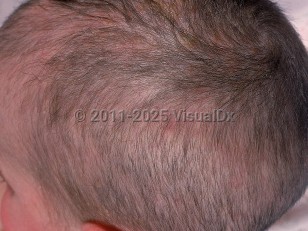Netherton syndrome in Infant/Neonate
See also in: Hair and ScalpAlerts and Notices
Important News & Links
Synopsis

Netherton syndrome (NS) is a rare genetic disorder characterized by the classical triad of congenital ichthyosiform erythroderma, trichorrhexis invaginata (bamboo hair), and an atopic diathesis.
NS is caused by mutations in the serine protease inhibitor SPINK5 (also known as LEKTI – lymphoepithelial Kazal type 5 related inhibitor) and is inherited in an autosomal-recessive fashion. SPINK5 is a regulator of skin inflammation, maturation, and desquamation through inhibition of epidermal kallikreins. Loss of SPINK5 function results in increased skin inflammation and defective skin barrier function. The incidence of NS may be as high as 1 in 50 000 live births. The disorder is reported in all ethnicities, with female patients affected more than male patients.
NS is characterized by diffuse ichthyosiform erythroderma with generalized scaling and peeling of the skin at birth and sparse hair or congenital alopecia. Twenty percent of neonates experience complications from electrolyte imbalance, thermoregulatory problems, pneumonia, and/or sepsis and show failure to thrive. In addition, there is an increased susceptibility to skin and respiratory infections and failure to thrive in infancy; most patients are below the 25th percentile in height and weight.
Beyond infancy, clinical signs are variable but tend to improve with time. Many patients will have cutaneous complications limited to an eczematous rash or a serpiginous migratory annular erythema with double-edged peripheral scaling named ichthyosis linearis circumflexa, a distinctive feature of NS. Pruritus is common. In patients with severe disease, the ichthyosiform erythroderma can persist through life. Although skin changes tend to improve with age, intermittent exacerbations are common. Many patients will also have hair abnormalities, primarily trichorrhexis invaginata, which develops in infancy but may also improve with age. The hair is generally sparse, short, and brittle.
Seventy-five percent of NS patients have an atopic diathesis and will be affected with atopic dermatitis, asthma, hay fever, food allergies, peripheral eosinophilia, and increased immunoglobulin E (IgE) levels.
NS is caused by mutations in the serine protease inhibitor SPINK5 (also known as LEKTI – lymphoepithelial Kazal type 5 related inhibitor) and is inherited in an autosomal-recessive fashion. SPINK5 is a regulator of skin inflammation, maturation, and desquamation through inhibition of epidermal kallikreins. Loss of SPINK5 function results in increased skin inflammation and defective skin barrier function. The incidence of NS may be as high as 1 in 50 000 live births. The disorder is reported in all ethnicities, with female patients affected more than male patients.
NS is characterized by diffuse ichthyosiform erythroderma with generalized scaling and peeling of the skin at birth and sparse hair or congenital alopecia. Twenty percent of neonates experience complications from electrolyte imbalance, thermoregulatory problems, pneumonia, and/or sepsis and show failure to thrive. In addition, there is an increased susceptibility to skin and respiratory infections and failure to thrive in infancy; most patients are below the 25th percentile in height and weight.
Beyond infancy, clinical signs are variable but tend to improve with time. Many patients will have cutaneous complications limited to an eczematous rash or a serpiginous migratory annular erythema with double-edged peripheral scaling named ichthyosis linearis circumflexa, a distinctive feature of NS. Pruritus is common. In patients with severe disease, the ichthyosiform erythroderma can persist through life. Although skin changes tend to improve with age, intermittent exacerbations are common. Many patients will also have hair abnormalities, primarily trichorrhexis invaginata, which develops in infancy but may also improve with age. The hair is generally sparse, short, and brittle.
Seventy-five percent of NS patients have an atopic diathesis and will be affected with atopic dermatitis, asthma, hay fever, food allergies, peripheral eosinophilia, and increased immunoglobulin E (IgE) levels.
Codes
ICD10CM:
Q80.8 – Other congenital ichthyosis
SNOMEDCT:
312514006 – Lamellar ichthyosis AND trichorrhexis invaginata syndrome (disorder)
Q80.8 – Other congenital ichthyosis
SNOMEDCT:
312514006 – Lamellar ichthyosis AND trichorrhexis invaginata syndrome (disorder)
Look For
Subscription Required
Diagnostic Pearls
Subscription Required
Differential Diagnosis & Pitfalls

To perform a comparison, select diagnoses from the classic differential
Subscription Required
Best Tests
Subscription Required
Management Pearls
Subscription Required
Therapy
Subscription Required
References
Subscription Required
Last Reviewed:06/18/2019
Last Updated:01/20/2022
Last Updated:01/20/2022
Netherton syndrome in Infant/Neonate
See also in: Hair and Scalp
